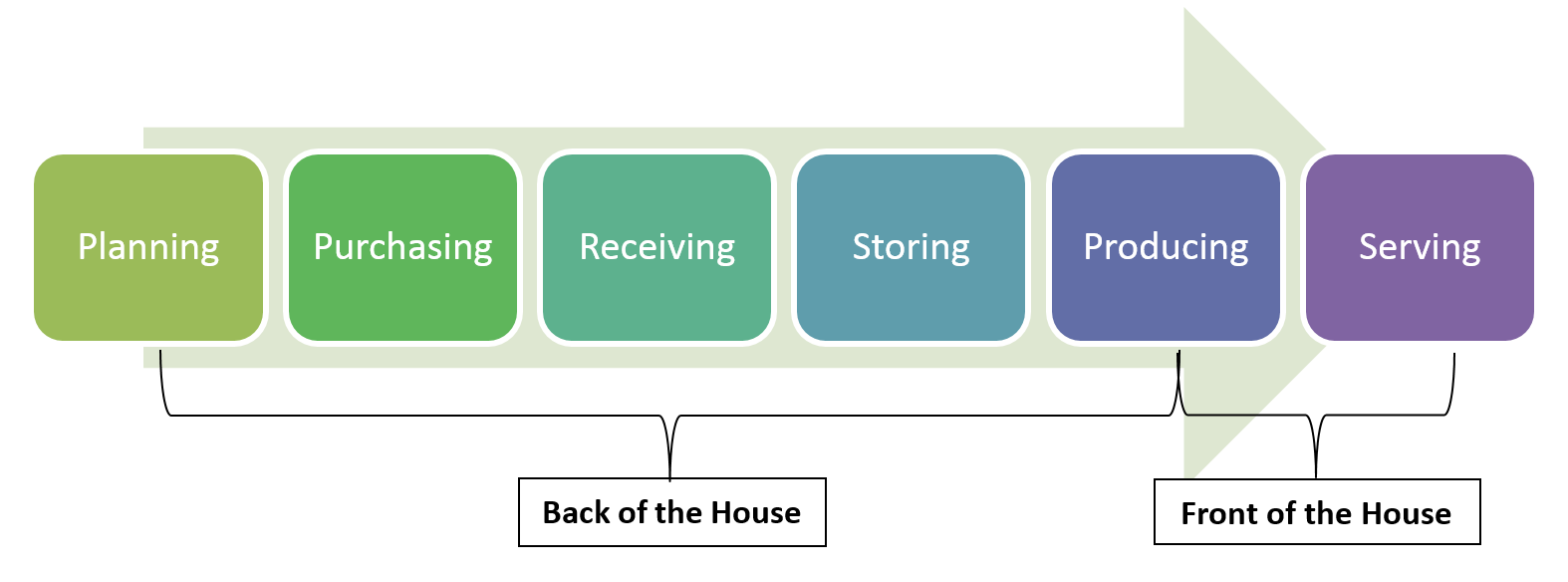
The US Food Waste Challenge encourages everyone, including K-12 schools, to reduce, recover, and recycle food waste. Waste can happen at any point in the school food service flow process (shown below in a graphic adapted from the Center of Excellence for Food Safety Research in Child Nutrition Programs). Food service staff can monitor every point of the process, and strategies to reduce food waste can be grouped into postconsumer or “front of the house” and pre-consumer or “back of the house” categories. Information learned along the way can be used to train employees to address problem areas!

Planning
Reviewing cafeteria policies and plans to identify what is being wasted and areas for improvement is a great place to start!
- Use a cycle menu for efficient ordering.
- Poll staff and students about most/least popular items to inform menu planning.
- Review food safety plans so food is not lost to poor receiving, storage, and production practices.
Purchasing
Use both external and internal resources or rely on internal information to identify potential areas to reduce waste!
- Perpetual inventories and the Food Buying Guide remove guess work from ordering.
- Purchase fresh products at shorter intervals with more frequent deliveries to avoid spoilage.
- Assess the most cost effective form based on food and labor costs and the amount of waste generated. Is cooking from scratch more cost effective? Could food byproducts be used somewhere else?
Receiving
All products should be inspected for quality and quantity in order to prevent food waste.
- Packages should be intact and have no signs of mishandling.
- Quickly move perishable food to storage to preserve quality and safety so that it can end up on trays and not in trash cans!
Storage
Food safety is essential for health, but it is also an important consideration for limiting food waste!
- Monitoring inventories and expiration dates can help staff move through stock appropriately.
- Organize products to help staff easily find and use older products first.
- Temperature logs can help identify problems in storage areas to avoid spoilage!
- Remember food can may be reused or recycled if stored appropriately and handled properly.
Production
Improving quality and acceptance of food during production sounds daunting, but it can be accomplished in small ways that encourage consumption and reduce waste.
- Try new seasoning methods or offer herbs and spices in seasoning shakers.
- If whole produce is served, pre-slicing and cutting makes items easier to eat.
- Using canned fruit? Try offering a few different varieties (and storing leftovers carefully), to encourage kids to eat their produce!
- Production records are great place to look for practices that can lead to food waste.
Service
Cafeteria staff, alone or with other departments, can encourage consumption to reduce waste during service.
- Scheduling lunch after recess and extending lunch periods by 10 minutes have both been shown to reduce plate waste about 30%!
- Making sure the lunch period is not very early or very late in the day can help make sure students are hungry for lunch!
- Communication between staff and students during service periods can go a long way in improving student selection and consumption.
- Taste testing, cooking demos, and/or kitchen tours may increase communication that can generate ideas to help reduce waste.
- Finally, check out Smarter Lunchrooms strategies, based in behavioral economics to encourage students to choose and consume healthy food options!
Read more:
- Decreasing Waste in Schools: Food Recycling Options
- School Food Recovery Programs – What are they and how do we get started?
Contributor
Alisha Gaines, PhD, Cornell University Division of Nutritional Sciences
Sources & Resources
Center of Excellence for Food Safety Research in Child Nutrition Programs
Feeding Hungry Tummies: Lunch Hour Strategies to Curb Food Waste
Food Buying Guide for School Meal Programs
Institute of Child Nutrition Education and Training Resources for School Nutrition Programs
Parents Play a Role in Curbing Food Waste at School
Plate Waste in School Nutrition Programs Final Report to Congress
U.S. Food Waste Challenge: K-12 Schools
U.S. Food Waste Challenge: Overview to K-12 Schools Webinar
Photo by USDA / CC BY http://creativecommons.org/licenses/by/2.0/
